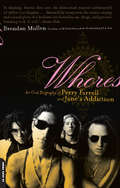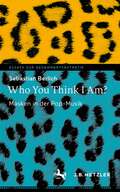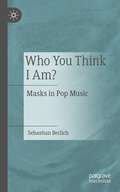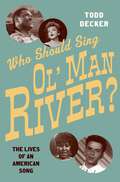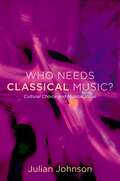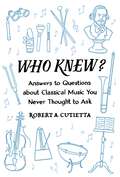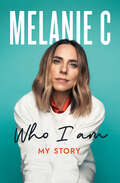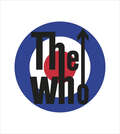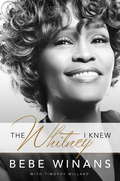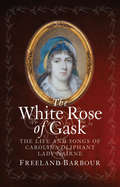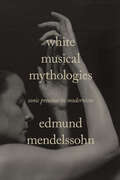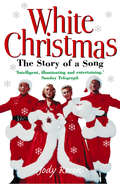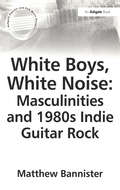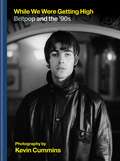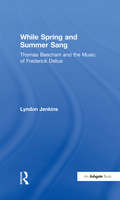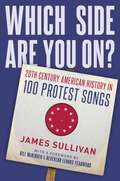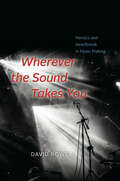- Table View
- List View
Whores: An Oral Biography of Perry Farrell and Jane's Addiction
by Brendan MullenJane's Addiction's 1988 breakthrough album, Nothing's Shocking, had a seismic impact. With a bracing combination of metal, punk, and psychedelia, coupled with lead singer Perry Farrell's banshee-ina- wind-tunnel vocals, Jane's Addiction helped put alternative music on the map. The band helped pave the way for the mainstream success of bands like Pearl Jam, Soundgarden, and Nirvana. Along the way, Jane's Addiction released another classic album, Ritual de lo Habitual (with the hit "Been Caught Stealing"), founded the Lollapalooza festival, and openly celebrated a bacchanalian lifestyle that blurred all lines of gender and sexuality. Drawn from original interviews with the band, their friends, and their musical colleagues, Whores takes readers through Farrell's early sonic experiments with Psi-Com and the formative days of Jane's Addiction to their drug-addled break-up and controversial reunion with 2003's Strays. Along the way it provides a candid, often disturbing glimpse into the dynamic alternative rock scene of Los Angeles in the '80s and '90s.
Whores: An Oral Biography of Perry Farrell and Jane's Addiction
by Brendan MullenJane's Addiction's 1988 breakthrough album, Nothing's Shocking, had a seismic impact. With a bracing combination of metal, punk, and psychedelia, coupled with lead singer Perry Farrell's banshee-ina- wind-tunnel vocals, Jane's Addiction helped put alternative music on the map. The band helped pave the way for the mainstream success of bands like Pearl Jam, Soundgarden, and Nirvana. Along the way, Jane's Addiction released another classic album, Ritual de lo Habitual (with the hit "Been Caught Stealing"), founded the Lollapalooza festival, and openly celebrated a bacchanalian lifestyle that blurred all lines of gender and sexuality. Drawn from original interviews with the band, their friends, and their musical colleagues, Whores takes readers through Farrell's early sonic experiments with Psi-Com and the formative days of Jane's Addiction to their drug-addled break-up and controversial reunion with 2003's Strays. Along the way it provides a candid, often disturbing glimpse into the dynamic alternative rock scene of Los Angeles in the '80s and '90s.
Who You Think I Am?: Masken in der Pop-Musik (Essays zur Gegenwartsästhetik)
by Sebastian BerlichPop-Stars sind uns nahe. In ihren Songs, ihren Bildern, ihren Stories auf Instagram. Gesucht ist ein authentischer Eindruck. Echte Gefühle auf echten Gesichtern. Aber was passiert, wenn sie ihr Gesicht mit einer Maske verdecken? Und zwar dauerhaft, als zweites Gesicht. Das Phänomen findet sich im Mainstream wie im Underground. Die Maske bricht dabei nicht mit dem Ideal von Authentizität. Vielmehr verweist sie je nach Inszenierung auf verschiedenste Diskurse, kann cool oder grotesk wirken, zum Logo werden oder Anonymität herstellen. Der Essay zeigt an zwei Beispielfällen (Sido, Slipknot), wie die Maske die Persona von Pop-Stars konstruiert – und enthüllt damit Strukturen der Pop-Musik.
Who You Think I Am?: Masks in Pop Music
by Sebastian BerlichPop stars are close to us. In their songs, their pictures, their stories on Instagram. What we are looking for is an authentic impression. Real feelings on real faces. But what happens when they cover their face with a mask? Permanently, as a second face. The phenomenon can be found in the mainstream as well as in the underground. The mask does not break with the ideal of authenticity. Rather, depending on how it is staged, it refers to the most diverse discourses, can appear cool or grotesque, become a logo or create anonymity. The essay uses mainly two examples (Sido, Slipknot) to show how the mask constructs the persona of pop stars - and thus reveals structures of pop music.
Who Should Sing 'Ol' Man River'?: The Lives of an American Song
by Todd DeckerA Broadway classic, a call to action, and an incredibly malleable popular song, "Ol' Man River" is not your typical musical theater standard. Written by Jerome Kern and Oscar Hammerstein II in the 1920s for Show Boat, "Ol Man River" perfectly blends two seemingly incongruous traits-the gravity of a Negro spiritual and the crowd-pleasing power of a Broadway anthem. Inspired by the voice of African American singer Paul Robeson, who adopted the tune for his own goals as an activist, "Ol' Man River" is both iconic and transformative. In Who Should Sing "Ol' Man River"? The Lives of an American Song, author Todd Decker examines how the song has shaped, and been shaped by, the African American experience. Yet "Ol' Man River" also transcends both its genre and original conception as a song written for an African American male. Beyond musical theater, this Broadway ballad has been reworked in musical genres from pop to jazz, opera to doo wop, rhythm and blues to gospel to reggae. Pop singers such as Bing Crosby, Frank Sinatra, and Judy Garland made "Ol' Man River" one of their signature songs. Jazz artists such as Bix Biederbecke, Duke Ellington, Dave Brubeck, Count Basie, and Keith Jarrett have all played "Ol' Man River," as have stars of the rock and roll era, such as Sam Cooke, Ray Charles, Aretha Franklin, the Temptations, Cher, and Rod Stewart. Black or white, male or female-anyone who sings "Ol' Man River" must confront and consider its charged racial content and activist history. Performers and fans of musical theater as well as students of the Civil Rights movement will find Who Should Sing "Ol' Man River" an unprecedented examination of a song that's played a groundbreaking role in American history.
Who Should Sing 'Ol' Man River'?: The Lives of an American Song
by Todd DeckerA Broadway classic, a call to action, and an incredibly malleable popular song, "Ol' Man River" is not your typical musical theater standard. Written by Jerome Kern and Oscar Hammerstein II in the 1920s for Show Boat, "Ol Man River" perfectly blends two seemingly incongruous traits-the gravity of a Negro spiritual and the crowd-pleasing power of a Broadway anthem. Inspired by the voice of African American singer Paul Robeson, who adopted the tune for his own goals as an activist, "Ol' Man River" is both iconic and transformative. In Who Should Sing "Ol' Man River"? The Lives of an American Song, author Todd Decker examines how the song has shaped, and been shaped by, the African American experience. Yet "Ol' Man River" also transcends both its genre and original conception as a song written for an African American male. Beyond musical theater, this Broadway ballad has been reworked in musical genres from pop to jazz, opera to doo wop, rhythm and blues to gospel to reggae. Pop singers such as Bing Crosby, Frank Sinatra, and Judy Garland made "Ol' Man River" one of their signature songs. Jazz artists such as Bix Biederbecke, Duke Ellington, Dave Brubeck, Count Basie, and Keith Jarrett have all played "Ol' Man River," as have stars of the rock and roll era, such as Sam Cooke, Ray Charles, Aretha Franklin, the Temptations, Cher, and Rod Stewart. Black or white, male or female-anyone who sings "Ol' Man River" must confront and consider its charged racial content and activist history. Performers and fans of musical theater as well as students of the Civil Rights movement will find Who Should Sing "Ol' Man River" an unprecedented examination of a song that's played a groundbreaking role in American history.
Who Needs Classical Music?: Cultural Choice and Musical Value
by Julian JohnsonDuring the last few decades, most cultural critics have come to agree that the division between "high" and "low" art is an artificial one, that Beethoven's Ninth and "Blue Suede Shoes" are equally valuable as cultural texts. In Who Needs Classical Music?, Julian Johnson challenges these assumptions about the relativism of cultural judgements. The author maintains that music is more than just "a matter of taste": while some music provides entertainment, or serves as background noise, other music claims to function as art. This book considers the value of classical music in contemporary society, arguing that it remains distinctive because it works in quite different ways to most of the other music that surrounds us. This intellectually sophisticated yet accessible book offers a new and balanced defense of the specific values of classical music in contemporary culture. Who Needs Classical Music? will stimulate readers to reflect on their own investment (or lack of it) in music and art of all kinds.
Who Needs Classical Music?: Cultural Choice and Musical Value
by Julian JohnsonDuring the last few decades, most cultural critics have come to agree that the division between "high" and "low" art is an artificial one, that Beethoven's Ninth and "Blue Suede Shoes" are equally valuable as cultural texts. In Who Needs Classical Music?, Julian Johnson challenges these assumptions about the relativism of cultural judgements. The author maintains that music is more than just "a matter of taste": while some music provides entertainment, or serves as background noise, other music claims to function as art. This book considers the value of classical music in contemporary society, arguing that it remains distinctive because it works in quite different ways to most of the other music that surrounds us. This intellectually sophisticated yet accessible book offers a new and balanced defense of the specific values of classical music in contemporary culture. Who Needs Classical Music? will stimulate readers to reflect on their own investment (or lack of it) in music and art of all kinds.
Who Knew?: Answers to Questions about Classical Music you Never Thought to Ask
by Robert A. CutiettaDid you ever leave an opera performance wondering why the singers use so much vibrato? Or a symphony, wondering who decided where on stage the orchestra members should sit, or why they tune their instruments to an oboe rather than an electronic tuner? Why is Tchaikovsky's 1812 Overture played on the 4th of July? And how does a composer choose what key to compose in? In Who Knew?: Answers to Questions about Classical Music You Never Thought to Ask, master music educator Robert A. Cutietta provides lucid answers to these and more than 140 other questions submitted by listeners to his popular weekly radio program. Through its pages, this highly readable guide touches on some of the most curiosity-inducing aspects of the tradition, from why audiences refrain from applauding between movements to how opera singers warm up on the night of a big debut. The responses are drawn from conversations with professional musicians and music educators, with additional contributions by Gail Eichenthal of KUSC, giving a rare glimpse into how musicians think and talk about their work. Lovers of classical music who would like to flesh out their understanding are sure to find a powerful resource in Cutietta's down-to-earth guide, and even seasoned listeners are sure to learn a thing or two. This book will provide hours of enjoyment as readers invariably shake their heads and ask in wonderment, "Who knew!"
Who Knew?: Answers to Questions about Classical Music you Never Thought to Ask
by Robert A. CutiettaDid you ever leave an opera performance wondering why the singers use so much vibrato? Or a symphony, wondering who decided where on stage the orchestra members should sit, or why they tune their instruments to an oboe rather than an electronic tuner? Why is Tchaikovsky's 1812 Overture played on the 4th of July? And how does a composer choose what key to compose in? In Who Knew?: Answers to Questions about Classical Music You Never Thought to Ask, master music educator Robert A. Cutietta provides lucid answers to these and more than 140 other questions submitted by listeners to his popular weekly radio program. Through its pages, this highly readable guide touches on some of the most curiosity-inducing aspects of the tradition, from why audiences refrain from applauding between movements to how opera singers warm up on the night of a big debut. The responses are drawn from conversations with professional musicians and music educators, with additional contributions by Gail Eichenthal of KUSC, giving a rare glimpse into how musicians think and talk about their work. Lovers of classical music who would like to flesh out their understanding are sure to find a powerful resource in Cutietta's down-to-earth guide, and even seasoned listeners are sure to learn a thing or two. This book will provide hours of enjoyment as readers invariably shake their heads and ask in wonderment, "Who knew!"
Who I Am: My Story THE SUNDAY TIMES BESTSELLER
by Melanie CFor the first time ever, Melanie C, aka Sporty Spice, tells her amazing life story in her own words and gives a full and honest account of what life was really like in The Spice Girls. THE SUNDAY TIMES BESTSELLER ___________'What a woman and what a book!' Elizabeth Day'Fabulous ... There is so much I really relate to, growing up as a young girl, the 90s, all the stuff you went through.' Zoe Ball'Amazing ... Absolutely brilliant.' Chris Evans'Sporty Spice telling it like it is.' Independent'An amazing story ... An incredibly profound, vulnerable and honest look into the highs and lows of the Spice Girls.' Steven Bartlett'Really lovely.' Chris Moyles ___________For the first time ever, Melanie C, aka Sporty Spice, tells her amazing life story in her own words and gives a full and honest account of what life was really like in The Spice Girls.I never told my story before because I wasn't ready. Now, finally, I am.25 years ago, The Spice Girls, a girlband that began after answering an advert in the paper, released our first single. 'Wannabe' became a hit and from that moment, my life changed for ever.I was suddenly part of one of the biggest music groups in history, releasing hit after hit, performing to our wonderful fans and spreading the message of Girl Power to the world. It was everything I'd dreamed of growing up, and I've had some incredible times... The BRITs! The movie! Travelling the world playing iconic venues like Madison Square Garden, The O2, Wembley Stadium and The London 2012 Olympics!!!When you're a woman, though, that power can be easily taken away by those around you, whether by pressure, exhaustion, shaming, bullying or a constant feeling like you aren't enough. I have been known as Sporty Spice, Mel C, Melanie C or just plain old Melanie Chisholm, but what you will read within the pages of this book is who I truly am, and how I found peace with that after all these years.I have really enjoyed reminiscing and getting everything down on the page, and, though revisiting some of my darkest times was hard, I hope this book can be inspiring and empowering as well as entertaining and give you a bit of a laugh.
The Who: The Official History
by Pete Townshend Roger Daltrey Ben MarshallFeaturing personal, never-before-published photographs, fan memorabilia and anecdotes, captions from Pete, newly discovered gems from The Who archive, an introduction by legendary Who manager Bill Curbishley and further contributions from friends, colleagues and family, this landmark illustrated book celebrates 50 years of anthemic, era-defining music and an extraordinary career.
The Whitney I Knew
by BeBe WinansA virtual album of BeBe Winans' treasured memories of his friend and "sister," Whitney Houston. In the years between the first time BeBe Winans and Whitney Houston met in 1985, to the day he delivered the tribute that touched a watching nation at Houston's funeral, a deep and unique friendship bloomed and thrived. They considered each other family in the truest sense of the word.
The White Rose of Gask: The Life and Songs of Carolina Oliphant, Lady Nairne
by Freeland BarbourCarolina Oliphant, Lady Nairne, a contemporary of Robert Burns, wrote over 80 songs which enjoyed great popularity during her lifetime and still do so up to the present day. They are some of Scotland’s most famous traditional songs – including ‘Charlie Is My Darling’, ‘A Hundred Pipers’, ‘Will Ye No’ Come Back Again’ and ‘The Laird of Cockpen’. Despite their popularity, she shunned publicity and never acknowledged her authorship in her lifetime, even concealing it from her husband for a time. After her death, the publication in 1846 of her collected songs and poems as Lays from Strathearn revealed her secret.Partly because of her lifelong reticence, details of her biography and her personality have remained little-known though her songs are famous, and this important Scottish literary figure has been neglected. Freeland Barber, a descendent of Lady Nairne, now presents a long-overdue biography and reassessment of her life and work, much of it based on research into family papers to which he has recently had access.
White Musical Mythologies: Sonic Presence in Modernism (Sensing Media: Aesthetics, Philosophy, and Cultures of Media)
by Edmund MendelssohnIn a narrative that extends from fin de siècle Paris to the 1960s, Edmund Mendelssohn examines modernist thinkers and composers who engaged with non-European and pre-modern cultures as they developed new conceptions of "pure sound." Pairing Erik Satie with Bergson, Edgard Varèse with Bataille, Pierre Boulez with Artaud, and John Cage with Derrida, White Musical Mythologies offers an ambitious critical history of the ontology of sound, suggesting that the avant-garde ideal of "pure sound" was always an expression of western ethnocentrism. Each of the musicians studied in this book re-created or appropriated non-European forms of expression as they conceived music ontologically, often thinking music as something immediate and immersive: from Satie's dabblings with mysticism and exoticism in bohemian Montmartre of the 1890s to Varèse's experience of ethnographic exhibitions and surrealist poetry in 1930s Paris, and from Boulez's endeavor to theorize a kind of musical writing that would "absorb" the sounds of non-European musical traditions to Cage, who took inspiration from Eastern thought as he wrote about sound, silence, and chance. These modernist artists believed that the presence effects of sound in their moment were more real and powerful than the outmoded norms of the European musical past. By examining musicians who strove to produce sonic presence, specifically by re-thinking the concept of musical writing (écriture), the book demonstrates that we cannot fully understand French theory in its novelty and complexity without music and sound.
White Musical Mythologies: Sonic Presence in Modernism (Sensing Media: Aesthetics, Philosophy, and Cultures of Media)
by Edmund MendelssohnIn a narrative that extends from fin de siècle Paris to the 1960s, Edmund Mendelssohn examines modernist thinkers and composers who engaged with non-European and pre-modern cultures as they developed new conceptions of "pure sound." Pairing Erik Satie with Bergson, Edgard Varèse with Bataille, Pierre Boulez with Artaud, and John Cage with Derrida, White Musical Mythologies offers an ambitious critical history of the ontology of sound, suggesting that the avant-garde ideal of "pure sound" was always an expression of western ethnocentrism. Each of the musicians studied in this book re-created or appropriated non-European forms of expression as they conceived music ontologically, often thinking music as something immediate and immersive: from Satie's dabblings with mysticism and exoticism in bohemian Montmartre of the 1890s to Varèse's experience of ethnographic exhibitions and surrealist poetry in 1930s Paris, and from Boulez's endeavor to theorize a kind of musical writing that would "absorb" the sounds of non-European musical traditions to Cage, who took inspiration from Eastern thought as he wrote about sound, silence, and chance. These modernist artists believed that the presence effects of sound in their moment were more real and powerful than the outmoded norms of the European musical past. By examining musicians who strove to produce sonic presence, specifically by re-thinking the concept of musical writing (écriture), the book demonstrates that we cannot fully understand French theory in its novelty and complexity without music and sound.
White Christmas: The Story Of A Song
by Jody Rosen"Not only is it the best song I ever wrote, it's the best song anybody ever wrote." Irving Berlin, 1942 A biography of the single most important record in the history of popular music
White Boys, White Noise: Masculinities and 1980s Indie Guitar Rock (Ashgate Popular and Folk Music Series)
by Matthew BannisterTo what extent do indie masculinities challenge the historical construction of rock music as patriarchal? This key question is addressed by Matthew Bannister, involving an in-depth examination of indie guitar rock in the 1980s as the culturally and historically specific production of white men. Through textual analysis of musical and critical discourses, Bannister provides the first book-length study of masculinity and ethnicity within the context of indie guitar music within US, UK and New Zealand 'scenes'. Bannister argues that past theorisations of (rock) masculinities have tended to set up varieties of working-class deviance and physical machismo as 'straw men', oversimplifying masculinities as 'men behaving badly'. Such approaches disavow the ways that masculine power is articulated in culture not only through representation but also intellectual and theoretical discourse. By re-situating indie in a historical/cultural context of art rock, he shows how masculine power can be rearticulated through high, avant-garde, bohemian culture and aesthetic theory: canonism, negation (Adorno), passivity, voyeurism and camp (Andy Warhol and the Velvet Underground), and primitivism and infantilism (Lester Bangs, Simon Reynolds). In a related vein, he also assesses the impact of Freud on cultural theory, arguing that reversing binary conceptions of gender by associating masculinities with an essentialised passive femininity perpetuates patriarchal dualism. Drawing on his own experience as an indie musician, Bannister surveys a range of indie artists, including The Smiths, The Jesus and Mary Chain, My Bloody Valentine and The Go-Betweens; from the US, R.E.M., The Replacements, Dinosaur Jr, Hüsker Dü, Nirvana and hardcore; and from NZ, Flying Nun acts, including The Chills, The Clean, the Verlaines, Chris Knox, Bailter Space, and The Bats, demonstrating broad continuities between these apparently disparate scenes, in terms of gender, aesthetic theory and approaches to popular musical history. The result is a book which raises some important questions about how gender is studied in popular culture and the degree to which alternative cultures can critique dominant representations of gender.
White Boys, White Noise: Masculinities And 1980s Indie Guitar Rock (Ashgate Popular and Folk Music Series)
by Matthew BannisterTo what extent do indie masculinities challenge the historical construction of rock music as patriarchal? This key question is addressed by Matthew Bannister, involving an in-depth examination of indie guitar rock in the 1980s as the culturally and historically specific production of white men. Through textual analysis of musical and critical discourses, Bannister provides the first book-length study of masculinity and ethnicity within the context of indie guitar music within US, UK and New Zealand 'scenes'. Bannister argues that past theorisations of (rock) masculinities have tended to set up varieties of working-class deviance and physical machismo as 'straw men', oversimplifying masculinities as 'men behaving badly'. Such approaches disavow the ways that masculine power is articulated in culture not only through representation but also intellectual and theoretical discourse. By re-situating indie in a historical/cultural context of art rock, he shows how masculine power can be rearticulated through high, avant-garde, bohemian culture and aesthetic theory: canonism, negation (Adorno), passivity, voyeurism and camp (Andy Warhol and the Velvet Underground), and primitivism and infantilism (Lester Bangs, Simon Reynolds). In a related vein, he also assesses the impact of Freud on cultural theory, arguing that reversing binary conceptions of gender by associating masculinities with an essentialised passive femininity perpetuates patriarchal dualism. Drawing on his own experience as an indie musician, Bannister surveys a range of indie artists, including The Smiths, The Jesus and Mary Chain, My Bloody Valentine and The Go-Betweens; from the US, R.E.M., The Replacements, Dinosaur Jr, Hüsker Dü, Nirvana and hardcore; and from NZ, Flying Nun acts, including The Chills, The Clean, the Verlaines, Chris Knox, Bailter Space, and The Bats, demonstrating broad continuities between these apparently disparate scenes, in terms of gender, aesthetic theory and approaches to popular musical history. The result is a book which raises some important questions about how gender is studied in popular culture and the degree to which alternative cultures can critique dominant representations of gender.
While We Were Getting High: Britpop & the ‘90s in photographs with unseen images
by Kevin CumminsRemember Britpop and the '90s through hundreds of its most striking images - with many seen here for the very first time. Taken by renowned photographer Kevin Cummins, chief photographer at the NME for more than a decade, the images in this book explore the rise and fall of Cool Britannia and all that came with it.Nostalgic, anarchic and featuring contributions from icons of the Britpop era including Noel Gallagher and Brett Anderson, While We Were Getting High is a seminal portrait of a decade like no other.Artists featured include:OasisBlurSuedePulpElasticaSupergrassThe CharlatansGeneSleeperKula ShakerEchobellyThe Bluetones...and many more
While Spring and Summer Sang: Thomas Beecham and the Music of Frederick Delius
by Lyndon JenkinsSir Thomas Beecham is often described as having 'championed' the music of Frederick Delius, and this is no exaggeration. From the moment he heard Delius's music as a young man, Beecham was captivated by its strange, romantic beauty, and its hold on him remained firm. During the next 50 years, he promoted Delius's music through a series of unrivalled performances, unearthing early pieces, arranging others and recording most of them, sometimes more than once. Lyndon Jenkins provides the first in-depth study of this extraordinary creative relationship. Starting with the first meeting of the composer and conductor in 1907, Jenkins charts Beecham's gradual introduction of Delius's compositions to British and foreign audiences, the operatic premi‘s and revivals, the Delius festivals that he organized in 1929 and 1946, and the formation of the Delius Trust upon the composer's death in 1934. Also described is Beecham's continuing crusade for Delius's music up to his own death in 1961, which included a model edition of the scores, a biography and an internationally celebrated recorded legacy. The book includes a critical discography. Lyndon Jenkins provides a vivid account of an achievement that remains without parallel in the history of British music.
While Spring and Summer Sang: Thomas Beecham and the Music of Frederick Delius
by Lyndon JenkinsSir Thomas Beecham is often described as having 'championed' the music of Frederick Delius, and this is no exaggeration. From the moment he heard Delius's music as a young man, Beecham was captivated by its strange, romantic beauty, and its hold on him remained firm. During the next 50 years, he promoted Delius's music through a series of unrivalled performances, unearthing early pieces, arranging others and recording most of them, sometimes more than once. Lyndon Jenkins provides the first in-depth study of this extraordinary creative relationship. Starting with the first meeting of the composer and conductor in 1907, Jenkins charts Beecham's gradual introduction of Delius's compositions to British and foreign audiences, the operatic premi‘s and revivals, the Delius festivals that he organized in 1929 and 1946, and the formation of the Delius Trust upon the composer's death in 1934. Also described is Beecham's continuing crusade for Delius's music up to his own death in 1961, which included a model edition of the scores, a biography and an internationally celebrated recorded legacy. The book includes a critical discography. Lyndon Jenkins provides a vivid account of an achievement that remains without parallel in the history of British music.
Which Side Are You On?: 20th Century American History in 100 Protest Songs
by James SullivanWhen he emerged from the nightclubs of Greenwich Village, Bob Dylan was often identified as a "protest" singer. As early as 1962, however, Dylan was already protesting the label: "I don't write no protest songs," he told his audience on the night he debuted "Blowin' in the Wind." "Protest" music is largely perceived as an unsubtle art form, a topical brand of songwriting that preaches to the converted. But popular music of all types has long given listeners food for thought. Fifty years before Vietnam, before the United States entered World War I, some of the most popular sheet music in the country featured anti-war tunes. The labor movement of the early decades of the century was fueled by its communal "songbook." The Civil Rights movement was soundtracked not just by the gorgeous melodies of "Strange Fruit" and "A Change Is Gonna Come," but hundreds of other gospel-tinged ballads and blues. In Which Side Are You On, author James Sullivan delivers a lively anecdotal history of the progressive movements that have shaped the growth of the United States, and the songs that have accompanied and defined them. Covering one hundred years of social conflict and progress across the twentieth century and into the early years of the twenty-first, this book reveals how protest songs have given voice to the needs and challenges of a nation and asked its citizens to take a stand--asking the question "Which side are you on?"
Which Side Are You On?: 20th Century American History in 100 Protest Songs
by James SullivanWhen he emerged from the nightclubs of Greenwich Village, Bob Dylan was often identified as a "protest" singer. As early as 1962, however, Dylan was already protesting the label: "I don't write no protest songs," he told his audience on the night he debuted "Blowin' in the Wind." "Protest" music is largely perceived as an unsubtle art form, a topical brand of songwriting that preaches to the converted. But popular music of all types has long given listeners food for thought. Fifty years before Vietnam, before the United States entered World War I, some of the most popular sheet music in the country featured anti-war tunes. The labor movement of the early decades of the century was fueled by its communal "songbook." The Civil Rights movement was soundtracked not just by the gorgeous melodies of "Strange Fruit" and "A Change Is Gonna Come," but hundreds of other gospel-tinged ballads and blues. In Which Side Are You On, author James Sullivan delivers a lively anecdotal history of the progressive movements that have shaped the growth of the United States, and the songs that have accompanied and defined them. Covering one hundred years of social conflict and progress across the twentieth century and into the early years of the twenty-first, this book reveals how protest songs have given voice to the needs and challenges of a nation and asked its citizens to take a stand--asking the question "Which side are you on?"
Wherever the Sound Takes You: Heroics and Heartbreak in Music Making
by David RowellDavid Rowell is a professional journalist and an impassioned amateur musician. He’s spent decades behind a drum kit, pondering the musical relationship between equipment and emotion. In Wherever the Sound Takes You, he explores the essence of music’s meaning with a vast spectrum of players, trying to understand their connection to their chosen instrument, what they’ve put themselves through for their music, and what they feel when they play. This wide-ranging and openhearted book blossoms outward from there. Rowell visits clubs, concert halls, street corners, and open mics, traveling from the Rock and Roll Hall of Fame in Cleveland to a death metal festival in Maryland, with stops along the way in the Swiss Alps and Appalachia. His keen reportorial eye treats us to in-depth portraits of musicians from platinum-selling legend Peter Frampton to a devout Christian who spends his days alone in a storage unit bashing away on one of the largest drum sets in the world. Rowell illuminates the feelings that both spur music’s creation and emerge from its performance, as well as the physical instruments that enables their expression. With an uncommon sensitivity and grace, he charts the pleasure and pain of musicians consumed with what they do—as all of us listen in.
